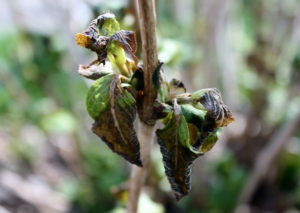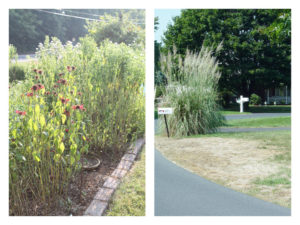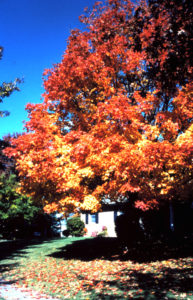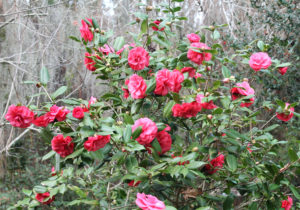Gardening in the New Climate
September 22nd, 2020
For better or worse (mostly for worse), it’s time to rethink how we garden in our new and changing climate conditions.
This summer served up a model for what climate researchers and horticulturists say we should get used to in the coming years – warmer winters, earlier springs, hotter/drier summers, increasingly erratic changes in temperature, and more weather extremes that alternate between ever-heavier rain dumpings and “flash droughts.”
All of these affect our plants and how we garden. And they’re getting hard to write off as occasional abnormalities.
I’m convinced we’re moving into a “new normal” that involves more than just getting used to warmer temperatures or planting more crape myrtles, nandinas, and other “southern” heat-lovers.
Nature is complicated. It’s so interconnected that even small changes in one facet can cause a ripple effect of changes throughout others.
I first noticed something was up about 20 years ago when a sugar maple in my front yard started growing smaller leaves than normal and lost its former fullness and vibrant fall color. The following fall it started leaning, and the next spring, it never leafed out at all. It just died.
There were no bugs, no disease, and no obvious explanation… until I read that Longwood Gardens was seeing the same problem and attributing it to increased heat.
Sugar maple is just one species that’s on the southern edge of its climate range here. As our climate becomes more like what Baltimore’s used to be, cool-preferring species are running into increasing trouble.
It’s behind why we’re losing so many Colorado blue spruces and why so many Japanese maples are struggling lately.
We’ll save a lot of money avoiding future plant deaths if we’re aware of the changes and base our plant-picking decisions on the coming climate.
Penn State Extension educator Vince Cotrone recently wrote an article pointing out that this is especially important for trees, which are big investments that are planted with the aim of living for decades.
Public gardens and universities are saying that, in addition to sugar maple, American beech, black cherry, linden, American hop-hornbeam, katsura, Sargent cherry, many spruces, and gray and white birch are trees that likely won’t fare well in our future climate.
Better climate bets are ginkgo, Freeman maple, blackgum, baldcypress, American hornbeam, American yellowwood, serviceberry, Chinese juniper, redbud, Eastern red cedar, Persian ironwood, sweetbay magnolia, hawthorn, and red and white oaks.
I just wrote a garden column for The Patriot-News and PennLive.com that goes into more detail on this and other impacts that gardeners can expect from the changing climate.
I also remember the time when snow covered the ground in December and stayed that way until the “spring melt.”
The snow insulated plant roots, and the consistent cold kept plants in their protected dormant state.
Now, see-sawing temperatures fool plants into coming out of dormancy early, only to be damaged when a cold front swoops down from the North.
We’ve all seen that happen lately, most recently this spring when prematurely opened hydrangea buds were killed and the first sets of tree and shrub leaves scorched and sometimes died.

Erratic ups and downs in temperature caused this kind of damage to new hydrangea growth this spring.
I lost a young Japanese maple this spring, for example, after two see-saws. The tree leafed out too early in our way-too-warm late winter, only to get zapped by an April freeze. Then it died altogether after a second set of leaves emerged and froze when temperatures dipped to a record-setting 30 degrees the night before Mother’s Day.
The erratic ups-and-downs also are behind the “mystery” of why Japanese maples and some other trees have been holding onto their browned leaves all winter lately.
Back in the “old days,” fall happened gradually, trees turned color, then the leaves browned and fell off.
Now, summer’s warmth often lingers well into October, putting off fall’s color change until a sudden nosedive turns leaves brown almost overnight. That’s a problem because trees don’t have a chance to seal off their leaf attachments and “push off” leaves, causing excess moisture loss in winter that can kill branches.
Those are just some of the more noticeable changes.
We’re also seeing heavier rain dumpings from more humid air (a result of warmth-fueled evaporation increases), hotter and drier summers (2020 was our hottest summer on record), new weeds (kudzu, the “vine that ate the South,” now overwinters in central Pennsylvania), more bugs (some are producing more than one generation a year), and increased plant stresses (leading to more diseases and greater vulnerability to all of those bugs).
The biggest concern, says Dr. Diane White Husic, dean of Moravian College’s School of Natural and Health Sciences in Bethlehem, is that climate changes are happening faster than plants can adapt.
Unlike people, they can’t get themselves a drink or hide out in the air-conditioning.
As Michigan State University horticulture professor Dr. Bert Cregg says, “If you’re a wildebeest in Africa and your water source dries up, you move to a different spot. Trees don’t have the option of moving if their environment changes.”
So what’s a gardener to do?
My latest Patriot-News/PennLive.com garden column goes into detail on 10 ways gardeners can adapt to the changing climate. Here’s the shortened version:
1.) Plant more trees. Their shade cools the air, their roots soak up those heavy downpours better than lawn, and they capture the airborne carbon that’s at the heart of the fast-warming climate.
2.) Switch to warmer-climate plants. We’ll be able to grow at least some “southern” plants (think osmanthus, camellias, Chinese fringe flowers, red hollies, etc.), although not everything might translate well due to differences in soils and daylengths.
3.) Switch out lawns for gardens. A diversity of trees, shrubs, evergreens, and perennials (especially native and well adapted choices) is way more eco-friendly than oceans of monoculture lawns cut weekly by gas-powered mowers and edgers. Mixed plantings absorb heat better, too.
4.) Lean toward more heat-tough flowers and vegetables. Some types take the heat better than others, and breeders have been developing new varieties with improved heat tolerance.
5.) Rethink planting schedules. We may be able to get started planting and gardening earlier in spring and going longer in fall, although we’ll still have to be on the lookout for those erratic temperature nosedives.
6.) Be ready to water. Hotter, drier summers will be the norm, so that means spending more time with the hose. Or consider automating the deed with sprinklers and/or drip-irrigation systems.
7.) Be ready for too much water. On the flip side, those deluges we’re seeing between the “flash droughts” can cause a lot of erosion and flooding damage. Strategies such as rain gardens, swales, and rock-lined dry-stream beds will make more and more sense.
8.) Step up your weeding program. Longer growing seasons mean more time for weeds to grow and elbow out desirable plants. Warmer winters mean new weeds from the South. Be vigilant, and never let a weed go to seed.
9.) Watch out for new pest bugs. Warmer temperatures also mean potentially new bugs that cold winters used to prevent or kill. Be alert for earlier and longer bug attacks in the warmer, longer growing seasons.
10.) Think about winter interest. Now that our winters are largely free of snow cover, plants are more visible in that previously forgotten “fourth season.” We might as well take advantage of it.










